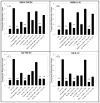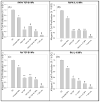Combinatorial delivery of immunosuppressive factors to dendritic cells using dual-sized microspheres
- PMID: 24778809
- PMCID: PMC4000038
- DOI: 10.1039/C3TB21460E
Combinatorial delivery of immunosuppressive factors to dendritic cells using dual-sized microspheres
Abstract
Microparticulate systems are beginning to show promise for delivery of modulatory agents for immunotherapeutic applications which modulate dendritic cell (DC) functions. Co-administration of multiple factors is an emerging theme in immune modulation which may prove beneficial in this setting. Herein, we demonstrate that localized, controlled delivery of multiple factors can be accomplished through poly (lactic-co-glycolic acid) (PLGA) microparticle systems fabricated in two size classes of phagocytosable and unphagocytosable microparticles (MPs). The immunosuppressive ability of combinatorial multi-factor dual MP systems was evaluated by investigating effects on DC maturation, DC resistance to LPS-mediated maturation and proliferation of allogeneic T cells in a mixed lymphocyte reaction. Phagocytosable MPs (~2 μm) were fabricated encapsulating either rapamycin (RAPA) or all-trans retinoic acid (RA), and unphagocytosable MPs (~30 μm) were fabricated encapsulating either transforming growth factor beta-1 (TGF-β1) or interleukin-10 (IL-10). Combinations of these MP classes reduced expression of stimulatory/costimulatory molecules (MHC-II, CD80 and CD86) in comparison to iDC and soluble controls, but not necessarily to single factor MPs. Dual MP-treated DCs resisted LPS-mediated activation, in a manner driven by the single factor phagocytosable MPs used. Dendritic cells treated with dual MP systems suppressed allogeneic T cell proliferation, generally demonstrating greater suppression by combination MPs than single factor formulations, particularly for the RA/IL-10 MPs. This work demonstrates feasibility of simultaneous targeted delivery of immunomodulatory factors to cell surface receptors and intracellular locations, and indicates that a combinatorial approach can boost immunoregulatory responses for therapeutic application in autoimmunity and transplantation.
Figures







Similar articles
-
Poly(2-propylacrylic acid)/poly(lactic-co-glycolic acid) blend microparticles as a targeted antigen delivery system to direct either CD4+ or CD8+ T cell activation.Bioeng Transl Med. 2017 Jul 11;2(2):202-211. doi: 10.1002/btm2.10068. eCollection 2017 Jun. Bioeng Transl Med. 2017. PMID: 29313030 Free PMC article.
-
A combination dual-sized microparticle system modulates dendritic cells and prevents type 1 diabetes in prediabetic NOD mice.Clin Immunol. 2015 Sep;160(1):90-102. doi: 10.1016/j.clim.2015.03.023. Epub 2015 Apr 2. Clin Immunol. 2015. PMID: 25842187 Free PMC article.
-
Latent, Immunosuppressive Nature of Poly(lactic-co-glycolic acid) Microparticles.ACS Biomater Sci Eng. 2018 Mar 12;4(3):900-918. doi: 10.1021/acsbiomaterials.7b00831. Epub 2018 Feb 3. ACS Biomater Sci Eng. 2018. PMID: 30555893 Free PMC article.
-
Particulate formulations for the delivery of poly(I:C) as vaccine adjuvant.Adv Drug Deliv Rev. 2013 Oct;65(10):1386-99. doi: 10.1016/j.addr.2013.05.013. Epub 2013 Jun 7. Adv Drug Deliv Rev. 2013. PMID: 23751781 Review.
-
The application of nanoparticles in cancer immunotherapy: Targeting tumor microenvironment.Bioact Mater. 2020 Dec 26;6(7):1973-1987. doi: 10.1016/j.bioactmat.2020.12.010. eCollection 2021 Jul. Bioact Mater. 2020. PMID: 33426371 Free PMC article. Review.
Cited by
-
Systemic Immunotherapy with Micellar Resiquimod-Polymer Conjugates Triggers a Robust Antitumor Response in a Breast Cancer Model.Adv Healthc Mater. 2021 May;10(10):e2100008. doi: 10.1002/adhm.202100008. Epub 2021 Mar 1. Adv Healthc Mater. 2021. PMID: 33646600 Free PMC article.
-
Poly(2-propylacrylic acid)/poly(lactic-co-glycolic acid) blend microparticles as a targeted antigen delivery system to direct either CD4+ or CD8+ T cell activation.Bioeng Transl Med. 2017 Jul 11;2(2):202-211. doi: 10.1002/btm2.10068. eCollection 2017 Jun. Bioeng Transl Med. 2017. PMID: 29313030 Free PMC article.
-
Micro and Nano Material Carriers for Immunomodulation.Am J Transplant. 2016 Dec;16(12):3362-3370. doi: 10.1111/ajt.13878. Epub 2016 Jun 27. Am J Transplant. 2016. PMID: 27214679 Free PMC article. Review.
-
Engineering Biomaterials to Direct Innate Immunity.Adv Ther (Weinh). 2019 Jun;2(6):1800157. doi: 10.1002/adtp.201800157. Epub 2019 Feb 27. Adv Ther (Weinh). 2019. PMID: 31236439 Free PMC article.
-
Conjugation of Transforming Growth Factor Beta to Antigen-Loaded Poly(lactide- co-glycolide) Nanoparticles Enhances Efficiency of Antigen-Specific Tolerance.Bioconjug Chem. 2018 Mar 21;29(3):813-823. doi: 10.1021/acs.bioconjchem.7b00624. Epub 2017 Nov 30. Bioconjug Chem. 2018. PMID: 29148731 Free PMC article.
References
-
- Banchereau J, Steinman RM. Nature. 1998;392:245. - PubMed
-
- Banchereau J, et al. Annual Review of Immunology. 2000;18:767. - PubMed
-
- Santini SM, Belardelli F. Stem Cells (Miamisburg) 2003;21:495. - PubMed
-
- Steinman RM, Hawiger D, Nussenzweig MC. Annual Review of Immunology. 2003;21:685. - PubMed
-
- Hackstein H, Thomson AW. Nature Reviews Immunology. 2004;4:24. - PubMed
Grants and funding
LinkOut - more resources
Full Text Sources
Other Literature Sources
Research Materials

